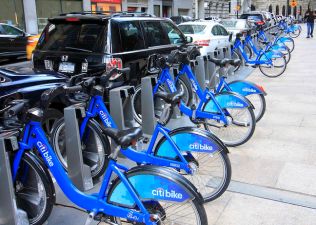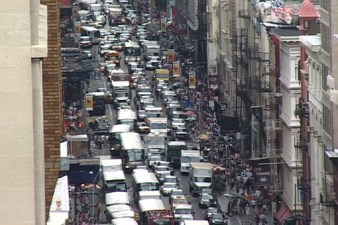How About a Transit System Where No One Has “No Good Options”?

A lengthy FiveThirtyEight article today by Nate Silver and Reuben Fischer-Baum crunches some data to arrive at two major insights: First, New Yorkers use Uber much like they use taxis, and second, for-hire cars are used primarily by well-off New Yorkers to supplement transit in close-in neighborhoods, not to replace car ownership in the outer boroughs.
The best part of the piece is actually a graphic that breaks down NYC’s transportation tribes, segmented by income and transit access. One of these groups didn’t get much attention in the article. See that red box? Here’s what Silver and Fischer-Baum say about that:
Low income, poor public transit access: In census tracts with no nearby subway line, 66 percent of households have access to a private vehicle. An exception among these neighborhoods, however, is those where incomes are below $35,000 per year: Car ownership remains low there. Given the high cost of living in New York, a $35,000 income is the equivalent of about $20,000 for an average American household, making even a clunker a stretch to afford. Families like these have no great choices.
This isn’t a small population. Of the 750,000 New Yorkers who commute more than an hour each way, two-thirds make less than $35,000 a year, according to a 2010 Pratt Center analysis. For comparison, only six percent of those hour-plus commuters made more than $75,000 annually. People of color carry the heaviest burden: Pratt’s numbers show that on average, black New Yorkers face commutes that are 25 percent longer than white New Yorkers. For Hispanics, commute times average 12 percent longer than for whites.
A report from the Rudin Center earlier this year echoed Pratt’s findings: More than two-thirds of residents in neighborhoods with mediocre transit access still relied on the bus or subway for their commutes, the report found. Residents in these neighborhoods had lower incomes and a higher unemployment rate than people in other parts of the city.
As housing prices in neighborhoods close to Manhattan with decent transit access continue to rise, low-income New Yorkers are increasingly moving to areas with sub-par transit access.
Compounding these challenges: The geography of employment is shifting, and the new patterns aren’t well-served by transit routes designed to get workers to and from Manhattan. Jobs in the outer boroughs are growing twice as fast as in Manhattan, according to the Regional Plan Association, with employment hubs including airports, hospitals, and industrial zones lacking decent transit access.
There are plans on the table to improve transit beyond the radial system with Manhattan at its center, including rail projects like the Triboro Rx or bringing Metro-North to the Hell Gate Line in the Bronx.
For years, the transit advocates and progressive politicians have made the case for a Bus Rapid Transit network, arguing that it provides the biggest bang for the city’s buck and can deliver transit improvements to the outer boroughs quickly.
To its credit, the de Blasio administration backs many of these ideas, and has promised to build 13 Select Bus Service routes. It’s also floated the idea of extending the Utica Avenue subway and backed smaller changes, like expanding the discounted CityTicket program for Metro-North and Long Island Rail Road riders in the five boroughs.
But progress is slow, and not just because rail expansions carry hefty price tags. Car-dependent residents with the ear of local elected officials have pushed back against bus lanes in eastern Queens. Even on Woodhaven Boulevard, where DOT is proposing the city’s most promising Select Bus Service upgrades, elected officials require lots of hand-holding.
It’s these neighborhoods where transit improvements have the greatest potential to transform the lives of New Yorkers. Uber gets the headlines, but it’s not going to solve these problems. For that, New York needs better transit in the outer boroughs.

